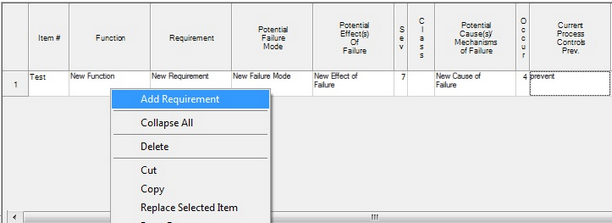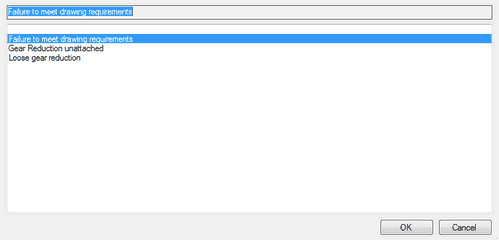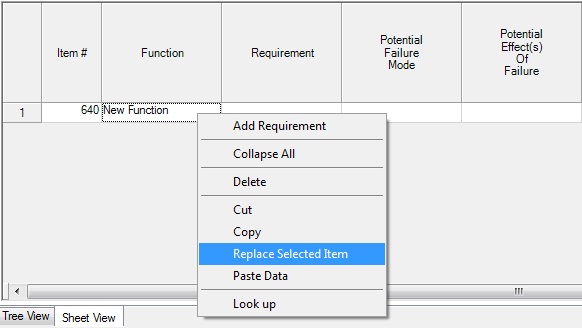Performing a PFMEA in the spreadsheet view takes a similar approach to the tree control, in that you first add a function, move on to the requirement, then the failure mode, then the effects of the failure, the cause, and finally to recommended actions. Instead of a vertical arrangement of the information, the cells fill in horizontally. To add a new level in the tree control, click on the 'parent' icon. In the sheet view, the concept is the same; to add the next level of information, click on the cell containing its 'parent'. For example, clicking on the Item # cell will allow you to add a new function to the adjacent cell.
To get started with a PFMEA, click the "Select" button in the PFMEA header. This will bring up a window that allows you to search for the operation, activity or routing to perform the analysis on. When you are searching for an operation or activity, you will first need to select the correct routing. Make sure you open the editor by clicking the "Edit" button at the bottom right of the screen.

Add a Requirement
Editing the data
In the spreadsheet view, editing the data becomes much simpler. You can copy and paste one or multiple cells. This allows for copying an entire function (with all the corresponding fields) and pasting under a new process.
The right-click menu contains several helpful functions for editing the data in the spreadsheet view:
•Copy: Duplicates the data from the selected cells. You can then paste it elsewhere.
•Cut: Takes the data from the current cell and allows you to move (paste) it elsewhere.
•Delete: You can delete a certain cell or an entire row. Deleting an item will also clear any cells in the same row that are to the right of that item's cell.
•Paste Data: The paste data function gives you two options. You can either paste the contents into one cell or you can paste the entire field along with all of the cells that are dependent on it. The format that data is pasted in depends on the destination cells.
•Replace Selected Item: This function allows you to overwrite the structure of the destination cell with whatever structure you have copied. The pasted data will retain the structure of the source and will overwrite the structure of the destination cells.
•Look up: This feature allows you to maintain a library of functions, requirements, failure modes, effect of failures and causes. As you create new fields, they are saved into the list of existing fields, providing a robust library. FMEA fields can be re-used across different processes and items this can make the language consistent and more easily understood. Clicking on Look up brings up a new window with a library inside. Make sure that the FMEA is saved before accessing the look up data.

Look Up Library
| In order to add a entry from the look up list, right-click on the field. Select the look up option. Select an entry from the list that appears. Click "OK". |
•Collapse (and Expand): Collapse allows you to reduce the spreadsheet view and see only certain rows. When the view is collapsed, the expand function appears on the right-click menu to undo the collapse.
Copying from Excel
Instead of entering and editing all FMEA information in Assembly Planner's editor, you can create the file in Excel and then copy it into Assembly Planner all at once. Once the file is created in Excel, you must follow the steps on the next page to import the data correctly.
1.Add one new function to the item (process) you have selected.
2.Make sure the order of your columns in your Excel file exactly match the order of the columns in Assembly Planner's editor.
3.In Excel, select and copy all cells you wish to import.
4.In Assembly Planner, highlight the New Function cell and right-click to select Replace Selected Item.

Replace Item
5.Check for errors (see below).
6.Click Save once errors are corrected.
Error Checking
The spreadsheet alerts you whenever the structure is out of sync. The system highlights the cell in red and the cell tip describes the error. An example error is shown below.

Error Checking
This error occurs because the potential effect of failure is missing, even though it has a cause. As the tip describes, enter an effect of failure or delete the effect, which will remove all information in cells to the right of the error. Make sure to save after correcting any errors.